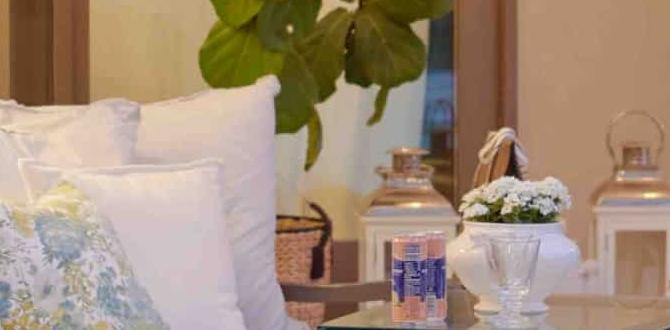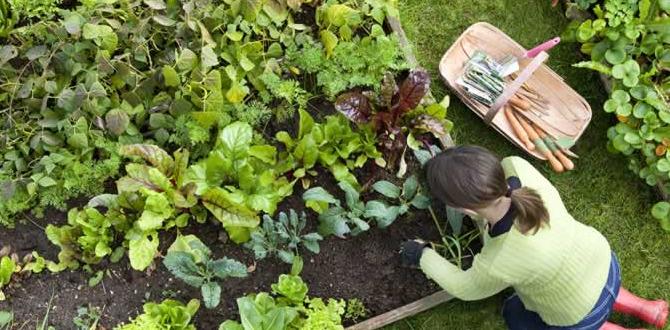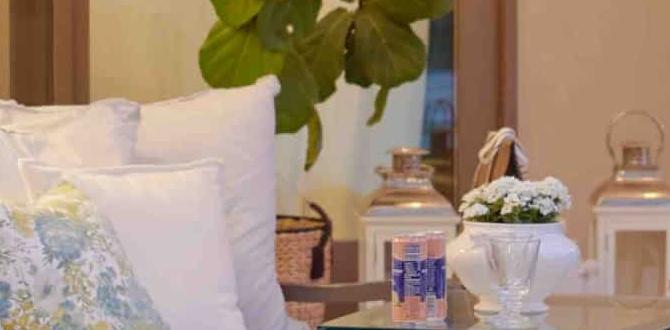Home gardening tips are easier than you think! This essential guide helps beginners create thriving indoor and outdoor gardens with simple steps, smart choices, and sustainable practices. Grow your own food, boost your home’s beauty, and reconnect with nature.
Wouldn’t it be wonderful to harvest fresh herbs for your dinner or see colorful blooms brighten your space? Many beginners feel overwhelmed by gardening, thinking it’s too hard or requires a magic green thumb. The truth is, with a few smart tips and a little patience, anyone can enjoy the rewarding experience of growing their own plants. This guide breaks down everything you need to know, from choosing the right spot to keeping your plants happy and healthy. Get ready to transform your home into a green oasis!
Why Start a Home Garden?
Embarking on a home gardening journey is an incredibly rewarding experience, bringing a touch of nature’s magic right to your doorstep. Whether you dream of fresh, homegrown vegetables, fragrant herbs, or simply the beauty of blooming flowers, a home garden can make it a reality. Beyond the aesthetic appeal, gardening offers a wealth of benefits for your well-being and your home environment.
For many, the allure of a home garden lies in the promise of fresh, organic produce. Imagine plucking ripe tomatoes for a salad or snipping fresh basil for your pasta – the taste and satisfaction are unparalleled. It’s also a fantastic way to reduce your grocery bill and know exactly where your food comes from, free from harmful pesticides.
Gardening also serves as a wonderful stress reliever. The simple act of tending to plants, whether indoors or out, can be incredibly therapeutic, offering a peaceful escape from the hustle and bustle of daily life. It’s a chance to slow down, connect with the earth, and engage in a mindful activity that nourishes both your plants and your soul.
Furthermore, a well-maintained garden can significantly enhance the beauty and value of your home. Vibrant flowers, lush greenery, and even well-placed edibles add curb appeal and create a more inviting atmosphere. For those living in apartments, container gardening and indoor plants can bring life and color to even the smallest spaces.
Choosing Your Gardening Adventure: Indoor vs. Outdoor
Before you get your hands dirty, it’s helpful to decide where your gardening adventure will take place. Both indoor and outdoor gardening offer unique joys and challenges, and the best choice for you depends on your living situation, available space, and personal preferences.
Indoor Gardening: Bringing the Outdoors In
Indoor gardening is perfect for those with limited outdoor space, living in apartments, or who want to enjoy plants year-round, regardless of the weather. It’s a fantastic way to add life, color, and even fresh ingredients to your home.
Benefits: Year-round growing, controlled environment, fresh herbs and produce readily available, air purification.
Challenges: Limited space, potential for pests, less natural light.
Popular indoor gardening options include:
- Herb Gardens: Grow basil, mint, rosemary, and chives on a sunny windowsill.
- Vegetable Patches: Smaller varieties of tomatoes, peppers, and salad greens can thrive in pots.
- Houseplants: From low-maintenance succulents to vibrant flowering plants, they beautify your space.
- Microgreens: Quick to grow and packed with nutrients, perfect for salads and sandwiches.
Outdoor Gardening: Embracing the Elements
Outdoor gardening allows you to utilize yard space for larger plants, enjoy the natural rhythms of the seasons, and connect with the wider ecosystem.
Benefits: More space for a variety of plants, natural sunlight and rain, can attract beneficial pollinators like bees and butterflies.
Challenges: Subject to weather conditions (frost, drought, storms), requires more physical effort, potential for deer, rabbits, and other garden pests.
Outdoor gardening can range from a few potted plants on a balcony to expansive vegetable beds and flower borders. Consider what you want to grow and how much time you can dedicate to your outdoor space.
Getting Started: Essential Home Gardening Tips for Beginners
No matter if you’re starting indoors or outdoors, a few fundamental tips will set you up for success. Think of these as your foundational steps to a thriving garden.
1. Location, Location, Location! (Sunlight is Key)
The most crucial factor for most plants is sunlight. Observe your space throughout the day to understand its sun exposure.
- Full Sun: Needs at least 6-8 hours of direct sunlight per day. Ideal for most vegetables (tomatoes, peppers, cucumbers) and many flowering plants.
- Partial Sun/Shade: Needs 4-6 hours of direct sunlight, ideally in the morning, with some shade during the hottest part of the afternoon. Good for leafy greens, root vegetables, and shade-tolerant flowers.
- Full Shade: Needs less than 4 hours of direct sunlight, or dappled light. Suitable for certain ferns, hostas, and some acid-loving plants.
For indoor gardeners, a south-facing window is often the best spot. If natural light is insufficient, consider investing in grow lights.
2. Soil Matters: The Foundation of Growth
Healthy plants start with healthy soil. Don’t just dig up dirt from your yard; most garden soil benefits from enrichment.
For Outdoor Gardens: If planting in the ground, amend your soil with compost. Compost adds nutrients, improves drainage, and helps retain moisture. A simple test for soil structure is to grab a handful: it should crumble easily, not form a hard, dense ball. If it’s very sandy or clay-heavy, adding compost is essential.
For Indoor/Container Gardening: Use a high-quality potting mix. These mixes are specially formulated for containers, providing good drainage and aeration that garden soil often lacks. Avoid using garden soil in pots, as it can compact and prevent water from draining properly. You can find excellent potting mixes at your local garden center. For a deeper dive into soil basics, resources from university extensions can be very helpful, like those from Penn State Extension.
3. What to Grow: Start Small and Simple
As a beginner, it’s wise to start with plants that are known to be forgiving and productive. This builds confidence and ensures early success.
Easy Outdoor Choices:
- Herbs: Basil, mint, chives, parsley.
- Leafy Greens: Lettuce, spinach, kale.
- Root Vegetables: Radishes, carrots (in looser soil).
- Fruiting Plants: Bush beans, a determinate (bush) variety of tomato.
Easy Indoor Choices:
- Herbs: Basil, mint, chives, cilantro.
- Leafy Greens: Loose-leaf lettuce, spinach.
- Radishes: Can be grown in shallow containers.
- Microgreens: Super fast and rewarding.
- Houseplants: Snake plants, Pothos, Spider Plants are very resilient.
4. Watering Wisely: The Art of Hydration
Overwatering and underwatering are two of the most common beginner mistakes. The key is to check the soil, not just water on a schedule.
The Finger Test: Stick your finger about an inch or two into the soil. If it feels dry, it’s time to water. If it feels moist, wait.
Water Deeply: When you water, do so until water drains from the bottom of the pot (for containers) or until the soil is thoroughly moistened several inches down (for in-ground gardens). This encourages roots to grow deeper.
Time of Day: Water in the early morning or late afternoon to reduce evaporation and prevent leaf scorch.
5. Container Gardening: Green Thumbs in Small Spaces
Container gardening is a versatile and accessible way to garden, whether you have a sprawling yard or a tiny balcony.
Choose the Right Pots: Ensure your containers have drainage holes! This is non-negotiable for preventing root rot. The size of the pot should be appropriate for the plant’s mature size. Larger plants need larger pots.
Potting Mix: Always use a quality potting mix for containers.
Watering Needs: Containers dry out faster than garden beds, so you’ll need to monitor moisture levels more closely.
A helpful guide to container gardening from the University of Florida IFAS Extension can offer more in-depth advice.
Essential Gardening Tools for Beginners
You don’t need a shed full of fancy equipment to start gardening. A few basic tools will make your tasks much easier and more enjoyable.
For Outdoor Gardening:
- Hand Trowel: For digging small holes, transplanting seedlings, and weeding.
- Hand Fork/Cultivator: For loosening soil and removing weeds.
- Watering Can or Hose with Sprayer: For gentle watering.
- Gloves: To protect your hands.
- Pruning Shears/Snips: For trimming and harvesting.
For Indoor Gardening:
The outdoor gardening list can largely apply, with a few indoor-specific additions:
- Small Watering Can: For precise watering.
- Spray bottle: For misting certain plants or applying pest control solutions.
- Mitts or small brush: For cleaning leaves or moving delicate plants.
Nurturing Your Plants: Ongoing Care and Companionship
Once your plants are in the ground or pot, the real magic begins: watching them grow! Here’s how to keep them thriving.
Feeding Your Plants: Nutrients for Growth
Plants need food, just like we do! While good soil provides a base, many plants benefit from supplemental feeding, especially in containers where nutrients can leach out.
Compost: Regularly top-dressing your outdoor beds with compost provides slow-release nutrients.
Organic Fertilizers: For a quicker boost, use organic fertilizers. These can be liquids, granules, or spikes available at garden centers. Look for balanced fertilizers (e.g., 10-10-10) or those tailored to specific plant types (like flowering plants or vegetables). Always follow package instructions to avoid over-fertilizing, which can harm your plants.
Indoor Plants: Most houseplants benefit from diluted liquid fertilizer during their growing season (spring and summer). Reduce or stop fertilizing in fall and winter when growth slows.
Pest Patrol: Keeping Unwanted Visitors at Bay
Pests are a common concern, but a healthy plant is often its own best defense. Early detection and simple, eco-friendly solutions are key.
Inspect Regularly: Make it a habit to check your plants (undersides of leaves too!) for any signs of pests like aphids, spider mites, or whiteflies.
Water Spray: A strong blast of water can dislodge many common pests.
Insecticidal Soap or Neem Oil: These are excellent, more natural options for controlling persistent pests. They work by suffocating or disrupting the pests. Always test on a small area of the plant first and follow product instructions carefully.
Companion Planting (Outdoor): Certain plants can deter pests. For example, marigolds can help deter nematodes, and basil planted near tomatoes may help repel flies and mosquitoes.
Weed Warriors: Keeping Unwanted Competition Down
Weeds compete with your desired plants for water, nutrients, and sunlight.
Mulching: Applying a layer of mulch (like wood chips, straw, or shredded leaves) around your plants is one of the best ways to suppress weeds. It also helps retain soil moisture and regulate soil temperature.
Hand Pulling: The most effective method for small gardens. Pull weeds when they are small and the soil is moist, ensuring you get the entire root.
Preventative Measures: Keeping your desired plants healthy and vigorous gives them a competitive edge over weeds.
Planning Your Garden Layout: A Smart Approach
Thinking about where your plants will go can make a big difference in their success and your gardening enjoyment.
Outdoor Garden Layout Tips:
| Consideration | Beginner-Friendly Approach |
|---|---|
| Sunlight Zones | Group plants with similar light needs together. Place sun-lovers in the sunniest spots and shade-tolerant plants in shadier areas. |
| Watering Access | If planting in beds, ensure they are close enough to a water source. Think about drip irrigation or soaker hoses for efficiency. |
| Plant Size & Growth Habit | Place taller plants like tomatoes or sunflowers at the back of beds so they don’t shade smaller plants. Consider how wide plants will spread. |
| Crop Rotation (for Veggies) | Avoid planting the same type of vegetable in the exact same spot year after year. This helps prevent soil-borne diseases and nutrient depletion. Simple rotation involves dividing your garden into sections and moving plant families around. |
| Companion Planting | Research beneficial plant pairings to deter pests and improve growth. |
Indoor Garden Layout Tips:
Light as Primary Factor: Arrange plants according to their light requirements around your home, prioritizing windows.
Grouping for Humidity: Plants that love humidity can be grouped together. You can even place a small humidifier or a tray filled with pebbles and water near them.
Accessibility: Place plants where you can easily water, prune, and admire them. Hanging planters, shelves, and plant stands can make the most of vertical space.
Air Circulation: Good airflow prevents fungal issues and helps strengthen plants. Avoid overcrowding them.
Seasonal Garden Care: Working with Nature’s Rhythm
Your garden will evolve throughout the year. Understanding the seasons helps you adapt your care routine.
Spring: The Season of Planting and Growth
- Outdoor: Start seeds indoors or buy seedlings after the last frost date. Prepare garden beds by adding compost. Plant cool-season crops like lettuce, spinach, and peas. Gradually introduce sun-loving plants as the weather warms.
- Indoor: This is a peak growing season for most houseplants. Start fertilizing regularly. Repot any plants that have outgrown their containers.
Summer: Peak Growth and Fruiting
- Outdoor: Water consistently, especially during hot, dry spells. Fertilize fruiting plants like tomatoes and peppers. Watch for pests and diseases. Harvest vegetables and herbs regularly to encourage more production.
- Indoor: Continue regular watering and fertilizing. Monitor for pests more diligently as warmer indoor temperatures can sometimes encourage them.
Fall: Harvesting and Preparation
- Outdoor: Harvest remaining crops. Plant fall crops like kale, spinach, and garlic. Clean up fallen leaves and debris. For perennial plants, provide winter protection if needed.
- Indoor: Gradually reduce watering and fertilizing as light levels decrease. Trim back any leggy growth. Bring any outdoor container plants inside before the first frost.
Winter: Rest and Planning
- Outdoor: Allow the garden to rest. Protect any sensitive plants. This is a great time for planning your next year’s garden, ordering seeds, and sharpening tools.
- Indoor: Water less frequently; most houseplants are dormant or growing very slowly. Avoid overwatering, which can lead to root rot. Enjoy the greenery your indoor plants provide.
Troubleshooting Common Gardening Problems
Even with the best intentions, you might encounter a hitch or two. Here are solutions to frequent issues:
Yellowing Leaves: Can indicate overwatering, underwatering, or nutrient deficiency. Check soil moisture first, then consider a balanced fertilizer if soil is consistently moist but growth is slow.
Wilting Plants: Often a sign of dehydration, but can also be caused by overwatering (roots drowning) or heat stress. Always check the soil moisture.
Leaf Spots/Discoloration: Could be fungal diseases. Improve air circulation, avoid overhead watering, and remove affected leaves. For outdoor gardens, ensure good soil drainage.
Leggy Seedlings/Plants: Lack of sufficient light. Move closer to a light source or use grow lights.
Frequently Asked Questions About Home Gardening
Q1: How often should I water my plants?
It’s best to water when the top inch or two of soil feels dry. This can be daily in hot weather for containers, or every few days for larger beds or less thirsty plants. Always check the soil moisture rather than watering on a strict schedule.
Q2: Do I really need to use fertilizer?
Fertilizer provides essential nutrients that plants need to grow. While rich soil offers some, especially in the first year, regular feeding, particularly for container plants and heavy feeders like vegetables, can significantly improve growth and yield. Organic options or compost are great.
Q3: What is the difference between a seed and a seedling?
A seed is the tiny package containing the beginnings of a plant, which needs to be planted in soil to germinate. A seedling is a young plant that has already sprouted from a seed and has developed its first true leaves, ready to be transplanted.
Q4: Can I grow vegetables inside my apartment?
Absolutely! Many vegetables, especially leafy greens, herbs, radishes, and dwarf varieties of tomatoes and peppers, can thrive indoors with adequate light (natural or from grow lights) and proper care, like using good potting mix and containers with drainage.
Q5: How do I deal with bugs on my plants?
Start by inspecting your plants carefully. Often, garden pests can be washed off with water. For more persistent issues





